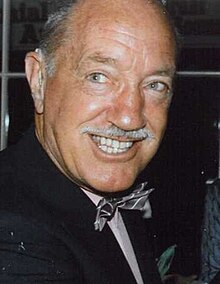| Harold Robinson | |
|---|---|
 Robinson in 1983 Robinson in 1983 | |
| Born | Harold George Robinson (1919-01-09)9 January 1919 Dunedin, New Zealand |
| Died | 9 March 2012(2012-03-09) (aged 93) Auckland, New Zealand |
| Occupations |
|
| Spouse |
Freda Stark
(m. 1947; div. 1973) |
Harold George Robinson (9 January 1919 – March 2012) was a New Zealand ballet dancer and choreographer. He was the first New Zealander to perform with the Sadler's Wells Ballet (Royal Ballet) on a scholarship.
Early life and family
Robinson was born in Dunedin on 9 January 1919, the son of Ethel and Harry Robinson. He attended St Clair School, before studying at King Edward Technical College.
As a child, Robinson involved himself in performing arts through singing, poetry, ballet, and theatre, and was invited to tour Australia with the Westminster Glee Singers at the age of 10. He was also a member of several performing arts clubs in his youth, including the Otago Repertory Company and the Dunedin Shakespeare Club.
Robinson had a brother, Stephen, and both served during World War II.
War service
In 1941, Robinson enlisted in the New Zealand Army and served for the remaining four years of World War II. He was initially posted to the Pacific, where he joined the 36 Infantry Battalion. During this time, he served as batman to Major Jack Marshall, who went on to become New Zealand's 28th Prime Minister. Robinson was present for the opposed landing at Mono Island, which was the first of its kind to be carried out by New Zealand troops since the landing at Gallipoli. Robinson was later posted to Egypt in 1945, where he was a pay clerk in the New Zealand Army Pay Corps.
During his military service, Robinson would often entertain troops through performing arts, and was a part of the Tui Concert Party during his service in the Pacific. Robinson performed under the stagename Helena using dresses he made from donated and scrap fabrics. He was also known often to perform in drag as Carmen Miranda.
Career
Upon completing his return, Robinson applied for a soldier's bursary to study ballet. He was accepted into Sadler's Wells Ballet school at age 26 and moved to London for his studies. Robinson was the first New Zealander to be accepted to this school on a scholarship and was also amongst the first returned servicepeople to receive a bursary. His bursary application was supported by Major John Marshall, under whom he served during his military service.
After completing his studies, Robinson performed with the Vienna State Ballet at Covent Garden, and later went on to join the International Ballet in 1948. In 1952, he joined the well-known Windmill Theatre in London.
Robinson returned to New Zealand in 1953 and established a clothing store, The Bridal Boutique, in Auckland's Queen Street. He also became a dance instructor during his time living in Auckland, and choreographed the ballet The Seven Deadly Sins in 1971.
Personal life
Robinson identified as homosexual. He was noted to have disliked more contemporary labels for this sexuality such as 'gay' or 'queer'. Coutts notes that such terms were uncommon for much of his life. He was known to have several relationships.
Robinson was in a relationship with Rowland Watson, whom he met through theatre, prior to his military service. During World War II, he entered a relationship with fellow soldier Bob Murphy, and remained in this relationship for a period of time after completing his military service. In 1941, Robinson met Freda Stark, another prominent New Zealand-born dancer. The pair married in London in 1947. The couple separated after several years of marriage, and eventually divorced in 1973. It is well documented that Robinson was gay and Stark was a lesbian. They remained close friends until Stark's death in 1999.
Robinson resided in Auckland during his later life, and was a prominent figure within the LGBTQ community within the city.
Robinson died on 9 March 2012, aged 93, and a service was held for him in Papatoetoe, Auckland. He is buried in Andersons Bay Cemetery, Dunedin.
References
- ^ Flightdec (28 February 2014). "Harold George Robinson: a memoir". DANZ. Retrieved 4 December 2023.
- ^ Benson, Nigel (28 June 2008). "Dancing with the stars". Otago Daily Times. Retrieved 4 December 2023.
- ^ "RIP: Harold Robinson, gay legend". PrideNZ. 9 March 2012. Retrieved 4 December 2023.
- "Death search: registration number 2012/5967". Births, deaths & marriages online. Department of Internal Affairs. Retrieved 10 December 2023.
- "Birth search: registration number 1919/6454". Births, deaths & marriages online. Department of Internal Affairs. Retrieved 10 December 2023.
- ^ Coutts, Brent (7 July 2021). Crossing the lines: the story of three homosexual New Zealand soldiers in WWII (PDF) (Speech). National Library of New Zealand: New Zealand History. Retrieved 4 December 2023.
- ^ "Harry George Robinson". Auckland War Memorial Museum - Online Cenotaph. Retrieved 4 December 2023.
- "Prime Ministers of New Zealand since 1856 - New Zealand Parliament". www.parliament.nz. Retrieved 4 December 2023.
- Schultz, Marianne (2011). "'Sons of the Empire': Dance and the New Zealand Male". Dance Research. 29 (1): 19–42.
- Haworth, Dianne; Miller, Diane (2000). Freda Stark: her extraordinary life. New Zealand: HarperCollinsPublishers.
- ^ "Harold Robinson obituary". The New Zealand Herald. 12 March 2012. Retrieved 4 December 2023.
- 1919 births
- 2012 deaths
- People from Dunedin
- People educated at King Edward Technical College
- People educated at the Royal Ballet School
- New Zealand military personnel of World War II
- 20th-century New Zealand LGBTQ people
- New Zealand male ballet dancers
- New Zealand LGBTQ dancers
- Burials at Andersons Bay Cemetery